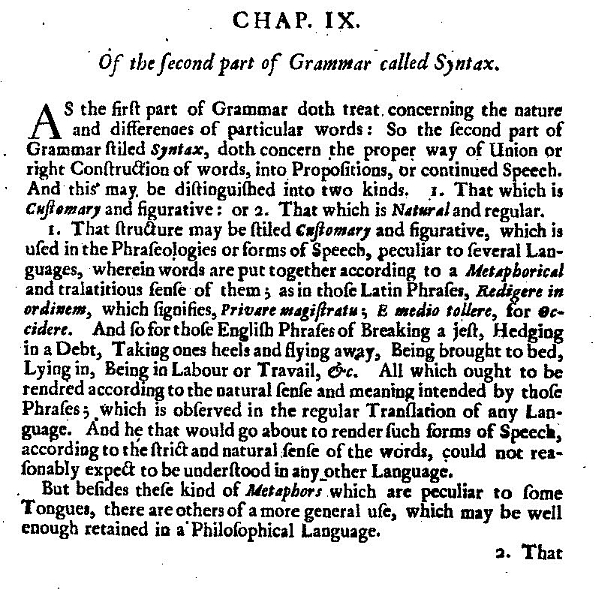



SOURCE: Wilkins, John. An Essay towards a Real Character, and a Philosophical Language. London: Printed for S. Gellibrand [etc.], 1668. [Contents: in PDF file, pp. 22-25] Part III: The Third Part Containing Philosophical Grammar: Chapter 9: Of the Second part of Grammar called Syntax; pp. 354-356 [in PDF pp. 388-390].
Note proposal on punctuation for irony, pp. 355-356 [in PDF pp. 389-390]. Additional bibliography & links supplied by R. Dumain.
Adorno, Theodor W. “Punctuation Marks,” in Notes to Literature; Volume One, edited by Rolf Tiedemann, translated by Shierry Weber Nicholsen (New York: Columbia University Press, 1991), pp. 91-97. See also John Wilkins & irony (3): Adorno postscript, and Theodor Adorno on the Art of Punctuation by Maria Popova (Brain Pickings).
Houston, Keith. Shady Characters: The Secret Life of Punctuation, Symbols & Other Typographical Marks (New York; London: W. W. Norton & Company, Inc., 2013), pp. 212-214.
Trettien, Whitney Anne. ‘The Sound of the Printed Letter’: Orthography, Orthoepy, Print and Dictionaries in Print Culture. Thesis, Hood College, 2007. See also author’s web site.
‘The Sound of the Printed Letter’: Orthography, Orthoepy, Print and the Naturalization of English Dictionaries. Queen’s University, June 3-5, 2010. Excerpt from full work (above).
Word and Self Estranged in English Texts, 1550-1660; edited by L. E. Semler, Philippa Kelly. Burlington, VT: Ashgate Publishing Company, 2010.
Wright Henderson, P. A. (Patrick Arkley). The Life and Times of John Wilkins, Warden of Wadham College, Oxford; Master of Trinity College, Cambridge; and Bishop of Chester. Edinburgh; London: W. Blackwood and Sons, 1910.
An Essay towards a Real Character, and a Philosophical Language - Wikipedia, the free encyclopedia
“The Analytical Language of John Wilkins” (originally ‘El idioma
analítico de John Wilkins’) by Jorge Luis Borges
Translated
by Lilia Graciela Vázquez
Translated by Will Fitzgerald
Spanish original & English
translation
Shady Characters: The secret life of punctuation. Irony & Sarcasm marks, part 1 of 3 by Keith Houston
“Ironic Serif: A Brief History of Typographic Snark and the Failed Crusade for an Irony Mark” by Maria Popova (Brain Pickings)
Irony punctuation - Wikipedia, the free encyclopedia.
See also Inverted question and exclamation marks
Ironisigno - Vikipedio (in Esperanto)
No Irony؟ by Timothy J. Attanucci (typography)
The Discovery of a World in the Moone: Or, A Discovrse Tending To Prove That ’Tis Probable There May Be Another Habitable World In That Planet. Printed by E.G. for Michael Sparke and Edward Forrest, 1638.
The mathematical and philosophical works of the Right Rev. John Wilkins, late lord bishop of Chester: to which is prefix’d the author’s life, and an account of his works. 2 vols. London: Vernor and Hood, 1802. Volume 1. Volume 2.
v. 1. I. The discovery of a new world; or, A discourse tending to prove, that it is probable there may be another habitable world in the moon. With a discourse of the possibility of a passage thither. — v. 1. II. That it is probable our earth is one of the planets. — v. 2. I. Mercury: or The secret and swift messenger. Shewing how a man may with privacy and speed communicate his thoughts to a friend at any distance. — v. 2. II. Mathematical magic: or, The wonders that may be performed by mechanical geometry. — v. 2. III. An abstract of his essay towards a real character, and a philosophical language
Mercury, or, The secret and swift messenger: Shewing, how a man may with privacy and speed communicate his thoughts to a friend at any distance. London: Printed for Richard Baldwin, 1694.
John Wilkins - Wikipedia, the free encyclopedia
The Republic of Codes: Cryptographic Theory and Scientific Networks in the Seventeenth Century by Robert Batchelor, November 1, 1999 [Work in Progress]
John Henry, Review of Lynch, William T., Solomon’s Child: Method in the Early Royal Society of London. H-Albion, H-Net Reviews. February, 2003.
Locke and Language, by Thomas Willard, reply by Ian Hacking, The New York Review of Books, October 7, 1982 [In response to: “Is Locke the Key?”, June 10, 1982]
Maarten Van Dyck and Koen Vermeir, Varieties of Wonder. John Wilkins’ mathematical magic and the perpetuity of invention. Preprint of article for Historia Mathematica, 2014.
“Forget Apollo and Sputnik: How a Briton launched the space race in the 1640s,” Daily Mail [London: Associated Newspapers Ltd], 2009.
The 17th-Century Language that Divided Everything in the Universe into 40 Categories by David Doochin, Atlas Obscura, July 28, 2016.
Ebleco de Vojaĝo al la Luno (el La Eltrovo de Nova Mondo) de John Wilkins, trad.William Auld (Esperanto translation)
Gulliver's Travels. Part III. A Voyage to Laputa, Balnibarbi, Luggnagg, Glubbdubdrib, and Japan. Chapter V (extract) by Jonathan Swift
La Granda Akademio en Lagado, el: Vojaĝo al Balnibarbi de Jonathan Swift, tradukis William Auld (Esperanto translation)
Ballad of Gresham College (1663)
William Blake vs Rationalist Linguistics (Excerpt) by Robert N. Essick
Jorge Luis Borges, Fritz Mauthner, & John Wilkins by Efraín Kristal
Bibliographies & web guides on this site
Philosophical and Universal Languages, 1600-1800, and Related Themes: Selected Bibliography
Irony, Humor, & Cynicism Study Guide
Home Page | Site
Map | What's New | Coming
Attractions | Book News
Bibliography | Mini-Bibliographies
| Study Guides | Special
Sections
My Writings | Other
Authors' Texts | Philosophical Quotations
Blogs | Images
& Sounds | External Links
CONTACT Ralph Dumain
Uploaded 27 August 2015
Last update 11 January 2023
Previous update 5 May 2021
Site ©1999-2023 Ralph Dumain